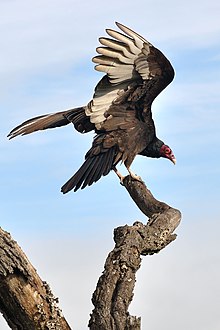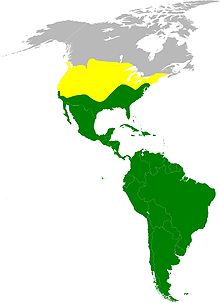
Hi Everybody!!
This is another first for me: a Mom and a baby buzzard coming over for Sunday dinner! In all the years I have known the buzzards, they have never come down to the ground in front of me before. Cassidy's Mom brought her here a few weeks ago (see past posts). I had offered a few dead things like a snake and squirrel as they would find out in the wild (on the road). They did not eat anything. Sunday dinner today was a big breakthrough for the question what does Cassidy like to eat? Today, they feasted as you will see in the photostudy below. The winning meal: chicken stock with poached egg and dog crunchies, softened! Enjoy this world exclusive of wild buzzards eating and drinking water in my yard!


Link to Album Gallery at G+
https://plus.google.com/u/0/photos/117645114459863049265/albums/6055250147522103585






https://en.wikipedia.org/wiki/Turkey_vulture
Turkey vulture
From Wikipedia, the free encyclopedia
The turkey vulture (Cathartes aura), also known in some North American regions as the turkey buzzard (or just buzzard), and in some areas of the Caribbean as the John crow or carrion crow,[2] is the most widespread of the New World vultures.[3] One of three species in the genus Cathartes, in the family Cathartidae, the turkey vulture ranges from southern Canada to the southernmost tip of South America. It inhabits a variety of open and semi-open areas, including subtropical forests, shrublands, pastures, and deserts.[1]
| Turkey vulture | |
|---|---|
 | |
| At Santa Teresa County Park, San Jose, California, US | |
| Conservation status | |
| Scientific classification | |
| Kingdom: | Animalia |
| Phylum: | Chordata |
| Class: | Aves |
| Order: | Cathartiformes |
| Family: | Cathartidae |
| Genus: | Cathartes |
| Species: | C. aura |
| Binomial name | |
| Cathartes aura (Linnaeus, 1758) | |
 | |
| Range of C. aura Summer only range Winter only range | |
Ecology and behavior[edit]
The turkey vulture is gregarious and roosts in large community groups, breaking away to forage independently during the day. Several hundred vultures may roost communally in groups which sometimes even include black vultures. It roosts on dead, leafless trees, and will also roost on man-made structures such as water or microwave towers. Though it nests in caves, it does not enter them except during the breeding season.[6] The turkey vulture lowers its night-time body temperature by about 6 degrees Celsius to 34 °C (93 °F), becoming slightly hypothermic.[30]
This vulture is often seen standing in a spread-winged stance. The stance is believed to serve multiple functions: drying the wings, warming the body, and baking off bacteria. It is practiced more often following damp or rainy nights. This same behavior is displayed by other New World vultures, by Old World vultures, and by storks.[7] Like storks, the turkey vulture often defecates on its own legs, using the evaporation of the water in the feces and/or urine to cool itself, a process known as urohidrosis.[39] It cools the blood vessels in the unfeathered tarsi and feet, and causes white uric acid to streak the legs.[40] The turkey vulture has few natural predators. Adult, immature and fledging vultures may fall prey to golden eagles, bald eagles and great horned owls, while eggs and nestlings may be preyed on by mammals such as raccoons, Virginia opossum and foxes.[7][23] Its primary form of defense is regurgitating semi-digested meat, a foul-smelling substance which deters most creatures intent on raiding a vulture nest.[6] It will also sting if the predator is close enough to get the vomit in its face or eyes. In some cases, the vulture must rid its crop of a heavy, undigested meal in order to take flight to flee from a potential predator.[28] Its life expectancy in the wild ranges upward of 16 years, with a captive life span of over 30 years being possible.[41][42]
The turkey vulture is awkward on the ground with an ungainly, hopping walk. It requires a great deal of effort to take flight, flapping its wings while pushing off the ground and hopping with its feet.[28] While soaring, the turkey vulture holds its wings in a shallow V-shape and often tips from side to side, frequently causing the gray flight feathers to appear silvery as they catch the light. The flight of the turkey vulture is an example of static soaring flight, in which it flaps its wings very infrequently, and takes advantage of rising thermals to stay soaring.[43]
Diet[edit]
The turkey vulture feeds primarily on a wide variety of carrion, from small mammals to large grazers, preferring those recently dead, and avoiding carcasses that have reached the point of putrefaction. They may rarely feed on plant matter, shoreline vegetation, pumpkin and other crops, live insects and other invertebrates.[37] In South America, turkey vultures have been photographed feeding on the fruits of the introduced oil palm.[44][45][46] They rarely, if ever, kill prey themselves.[47] The turkey vulture can often be seen along roadsides feeding on roadkill, or near bodies of water, feeding on washed-up fish.[4] They also will feed on fish or insects which have become stranded in shallow water.[6] Like other vultures, it plays an important role in the ecosystem by disposing of carrion which would otherwise be a breeding ground for disease.[48]
The turkey vulture forages by smell, an ability that is uncommon in the avian world, often flying low to the ground to pick up the scent of ethyl mercaptan, a gas produced by the beginnings of decay in dead animals.[7] The olfactory lobe of its brain, responsible for processing smells, is particularly large compared to that of other animals.[7] This heightened ability to detect odors allows it to search for carrion below the forest canopy. King vultures, black vultures, and condors, which lack the ability to smell carrion, follow the turkey vulture to carcasses. The turkey vulture arrives first at the carcass, or withgreater yellow-headed vultures or lesser yellow-headed vultures, which also share the ability to smell carrion.[7] It displaces the yellow-headed vultures from carcasses due to its larger size,[48]but is displaced in turn by the king vulture and both types of condor, which make the first cut into the skin of the dead animal. This allows the smaller, weaker-billed, turkey vulture access to food, because it cannot tear the tough hides of larger animals on its own. This is an example of mutual dependence between species.[49]
Reproduction[edit]
The breeding season of the turkey vulture varies according to latitude.[50] In the southern United States, it commences in March, peaks in April to May, and continues into June.[51] In more northerly latitudes, the season starts later and extends into August.[52] Courtship rituals of the turkey vulture involve several individuals gathering in a circle, where they perform hopping movements around the perimeter of the circle with wings partially spread. In the air, one bird closely follows another while flapping and diving.[37]
Eggs are generally laid in the nesting site in a protected location such as a cliff, a cave, a rock crevice, a burrow, inside a hollow tree, or in a thicket. There is little or no construction of a nest; eggs are laid on a bare surface. Females generally lay two eggs, but sometimes one and rarely three. The eggs are cream-colored, with brown or lavender spots around their larger end.[37] Both parents incubate, and the young hatch after 30 to 40 days. Chicks are altricial, or helpless at birth. Both adults feed the chicks by regurgitating food for them, and care for them for 10 to 11 weeks. When adults are threatened while nesting, they may flee, or they may regurgitate on the intruder or feign death.[6] If the chicks are threatened in the nest, they defend themselves by hissing and regurgitating.[37] The young fledge at about nine to ten weeks. Family groups remain together until fall.[37]
(Please see above link for complete Article)








Baby Cassidy eating from Mom's mouth

...this is brendasue (and buzzards) signing off from Rainbow Creek. See you next time!


O+O




No comments:
Post a Comment